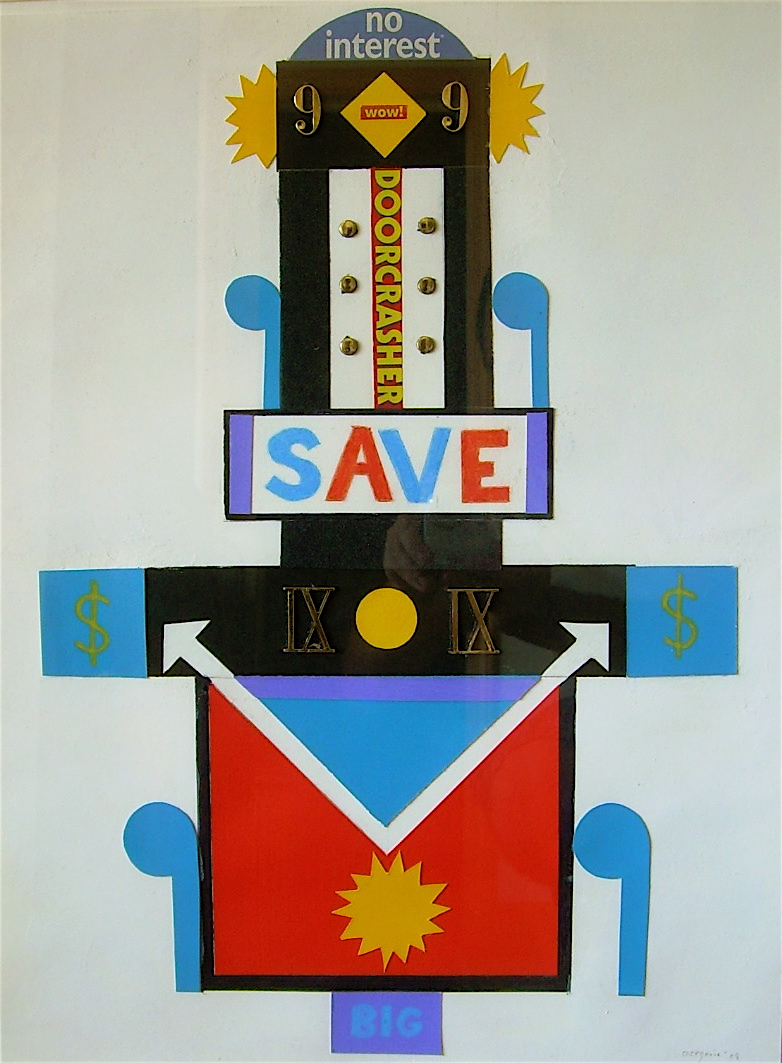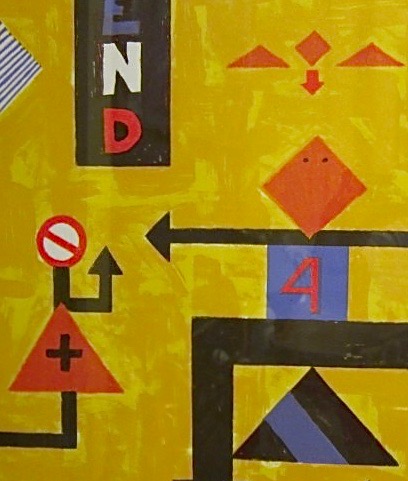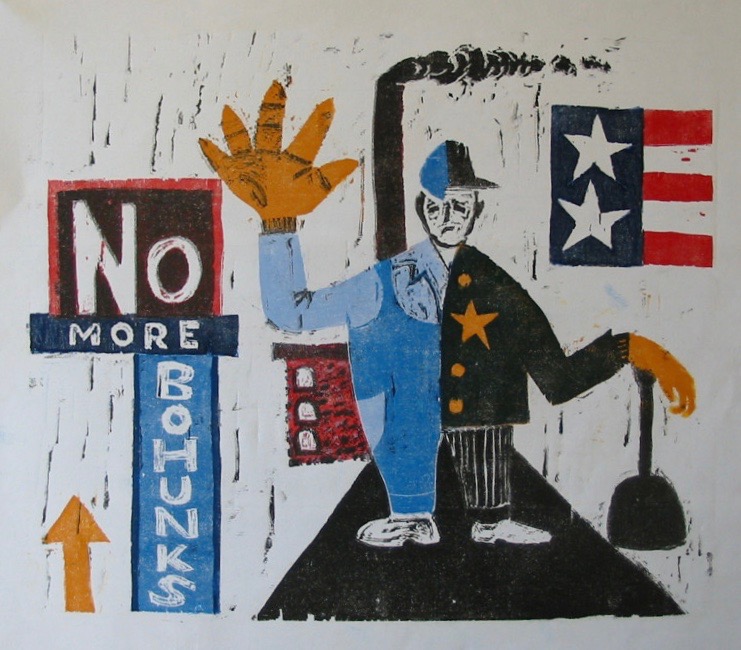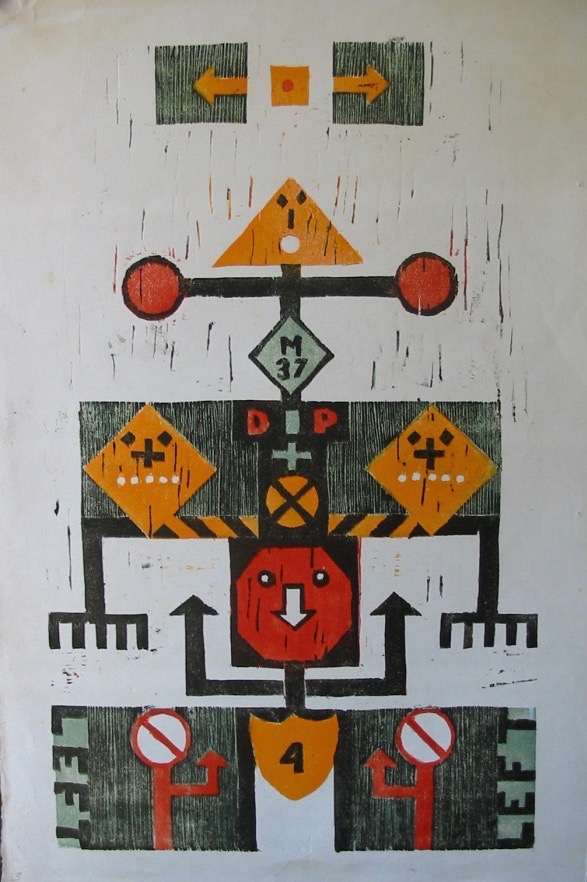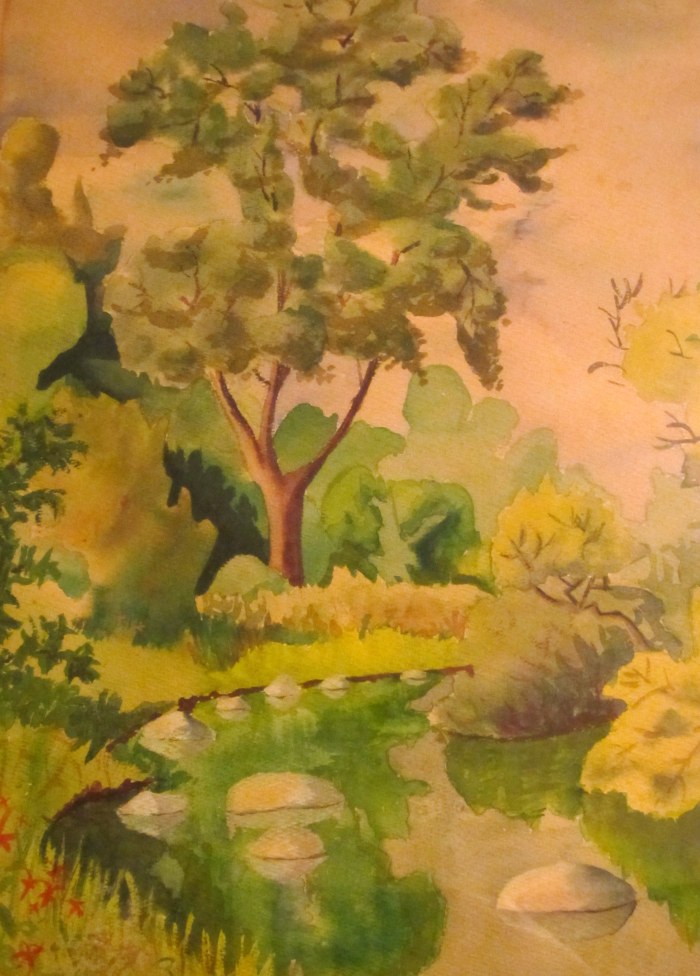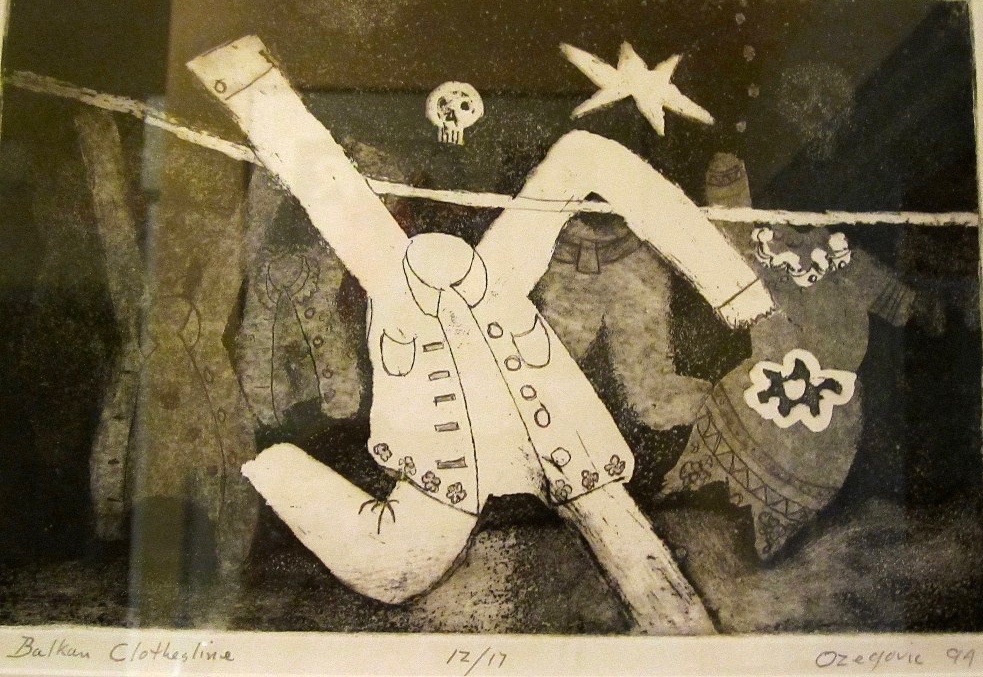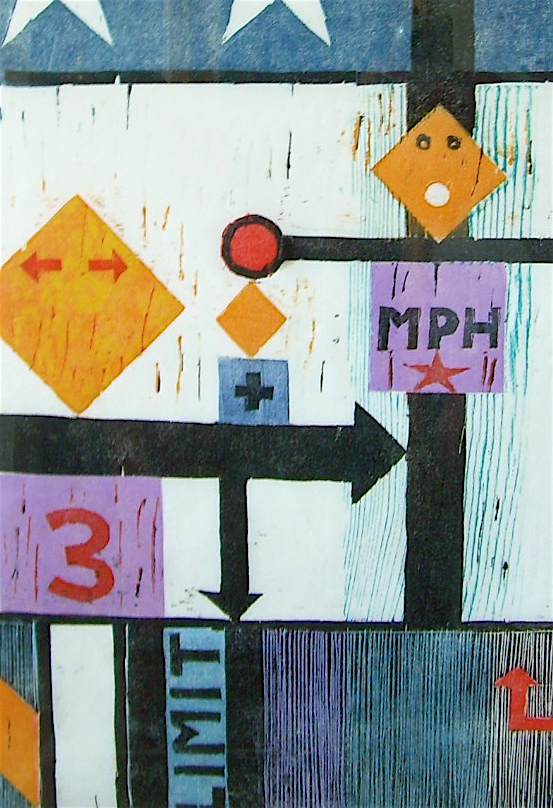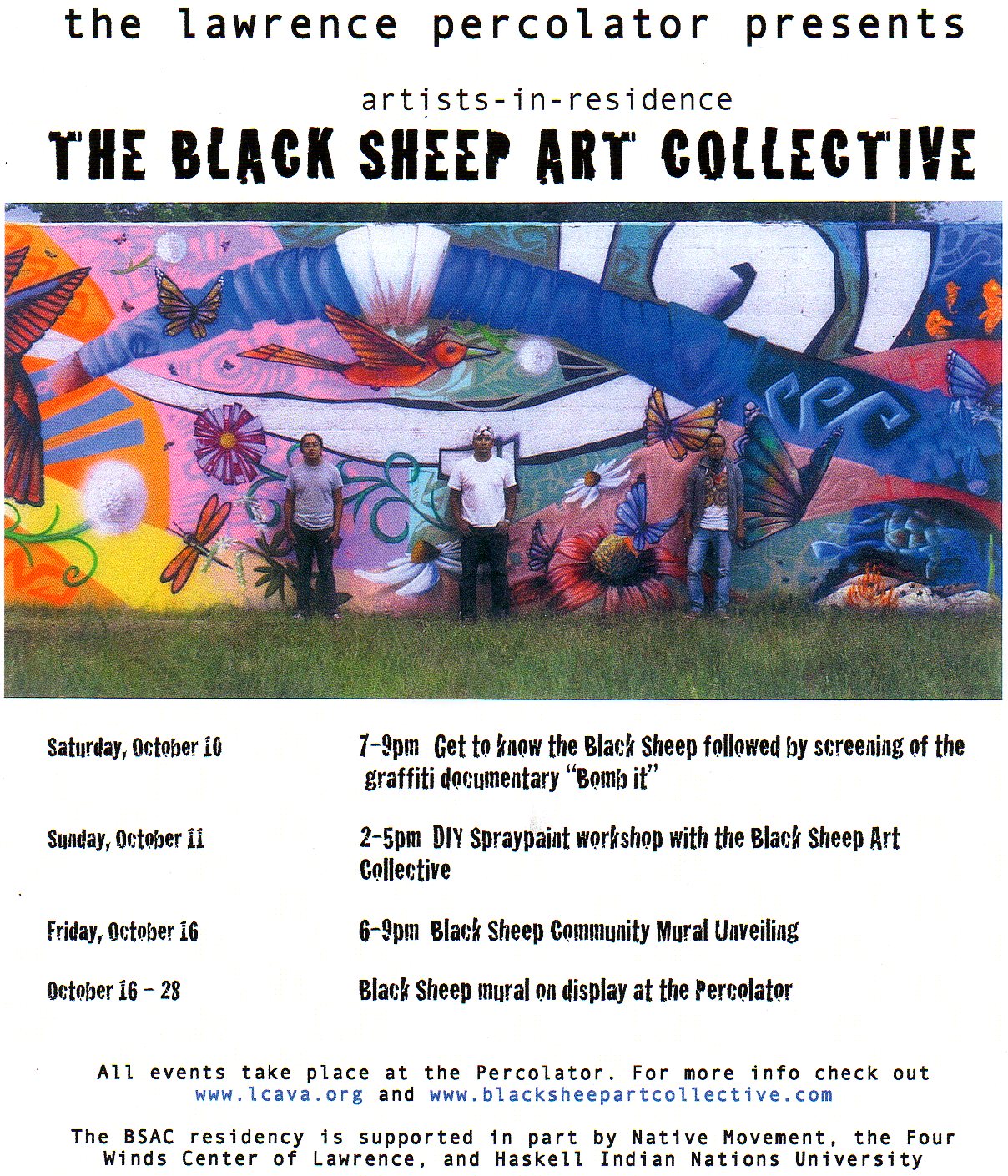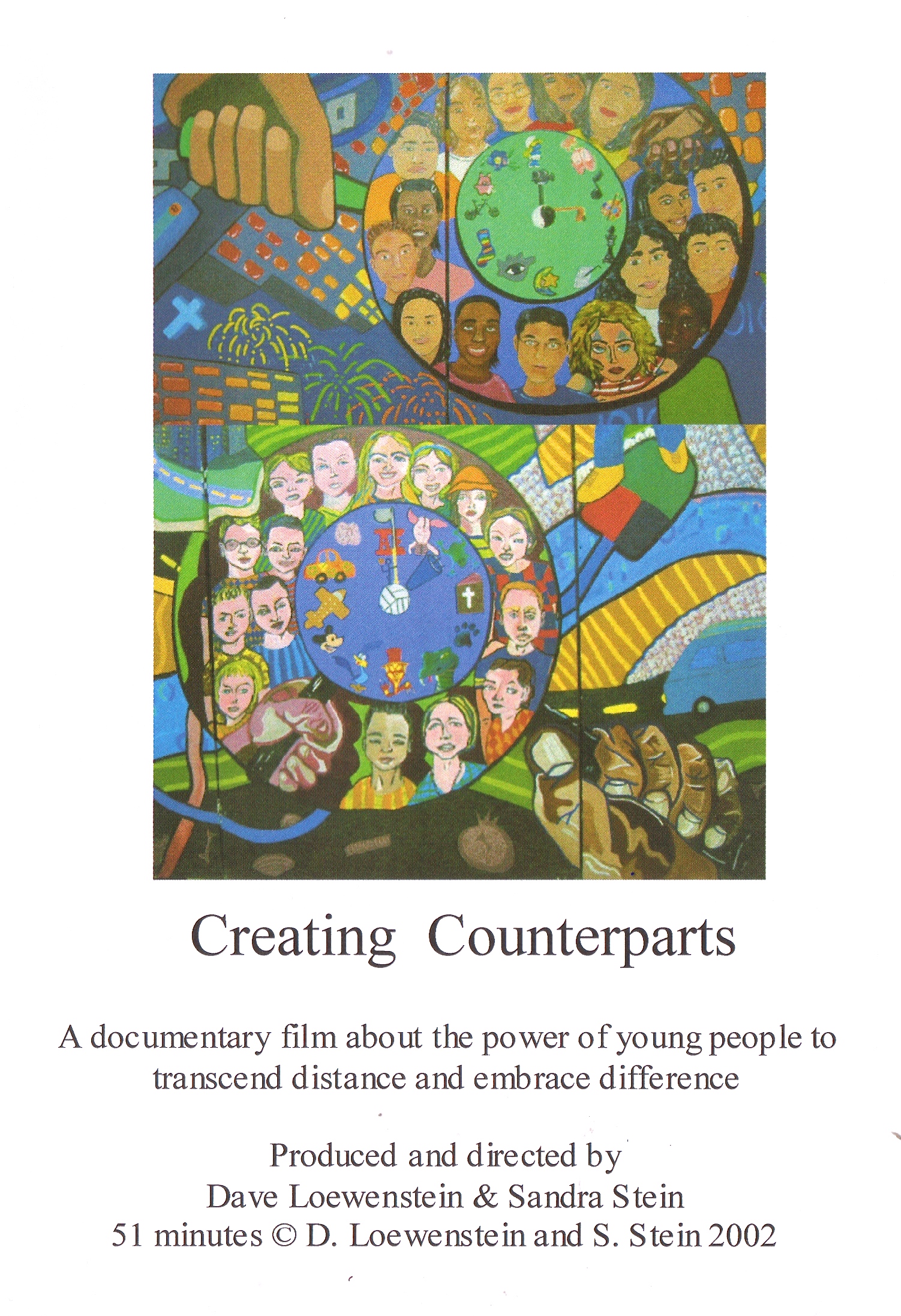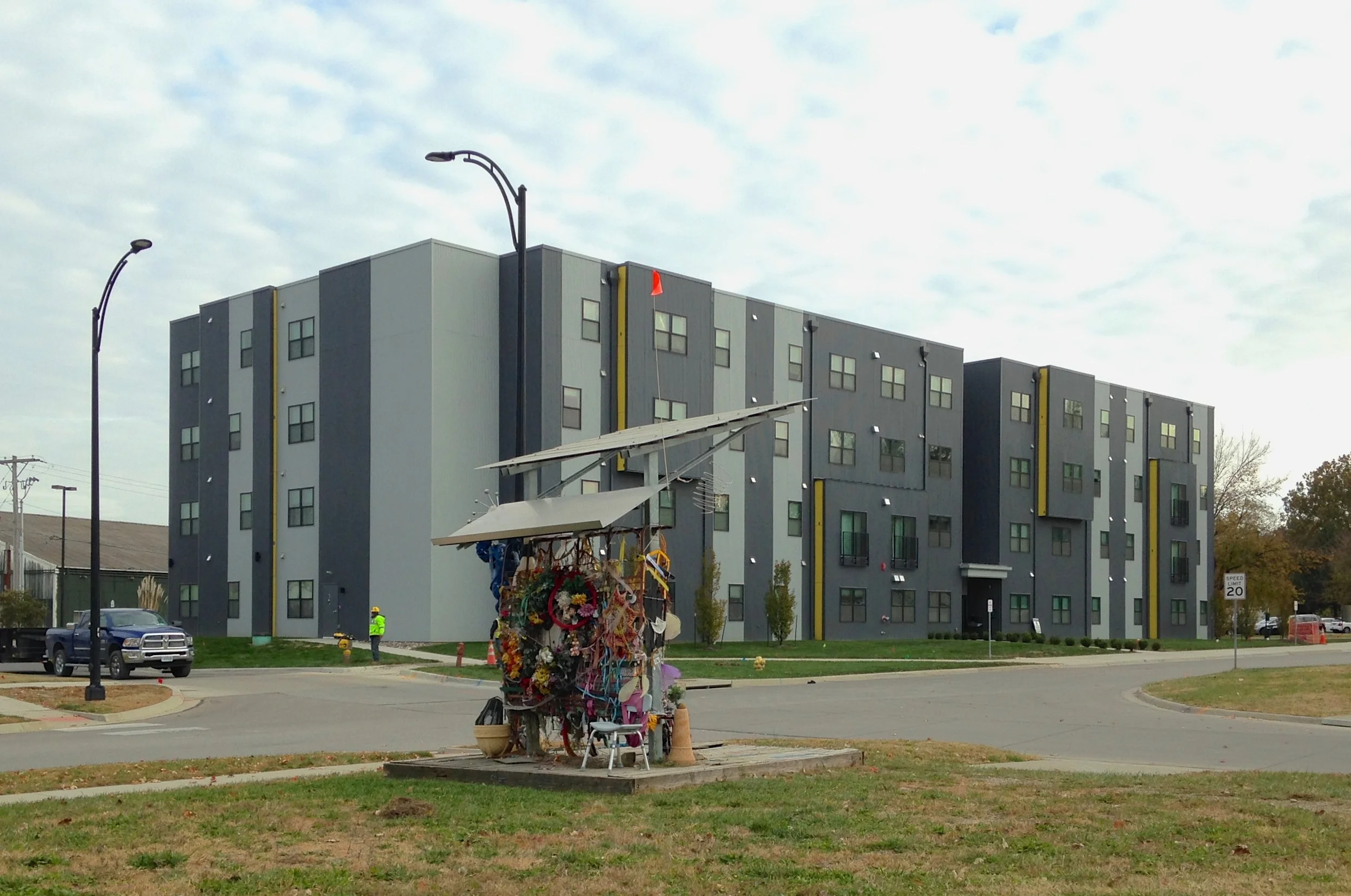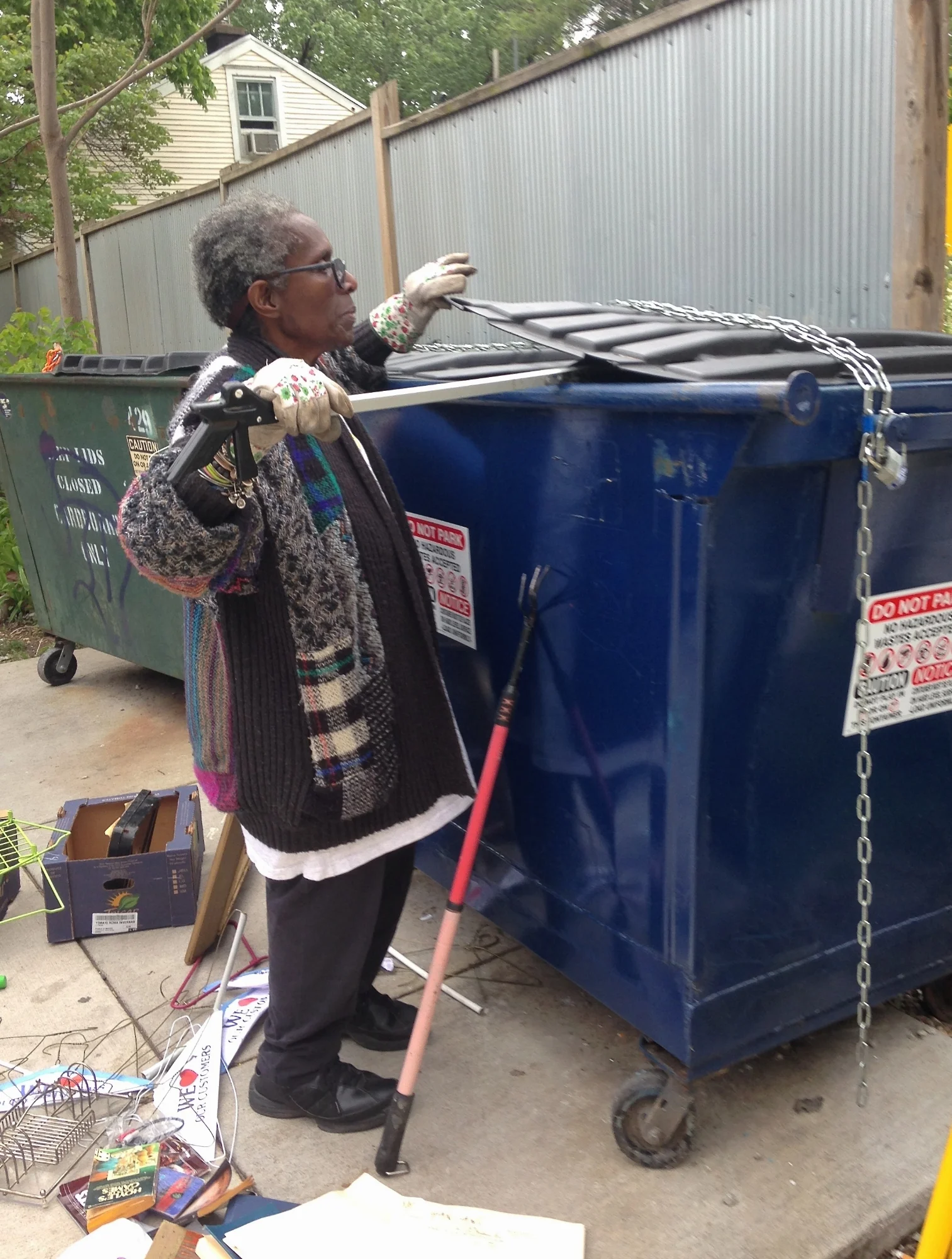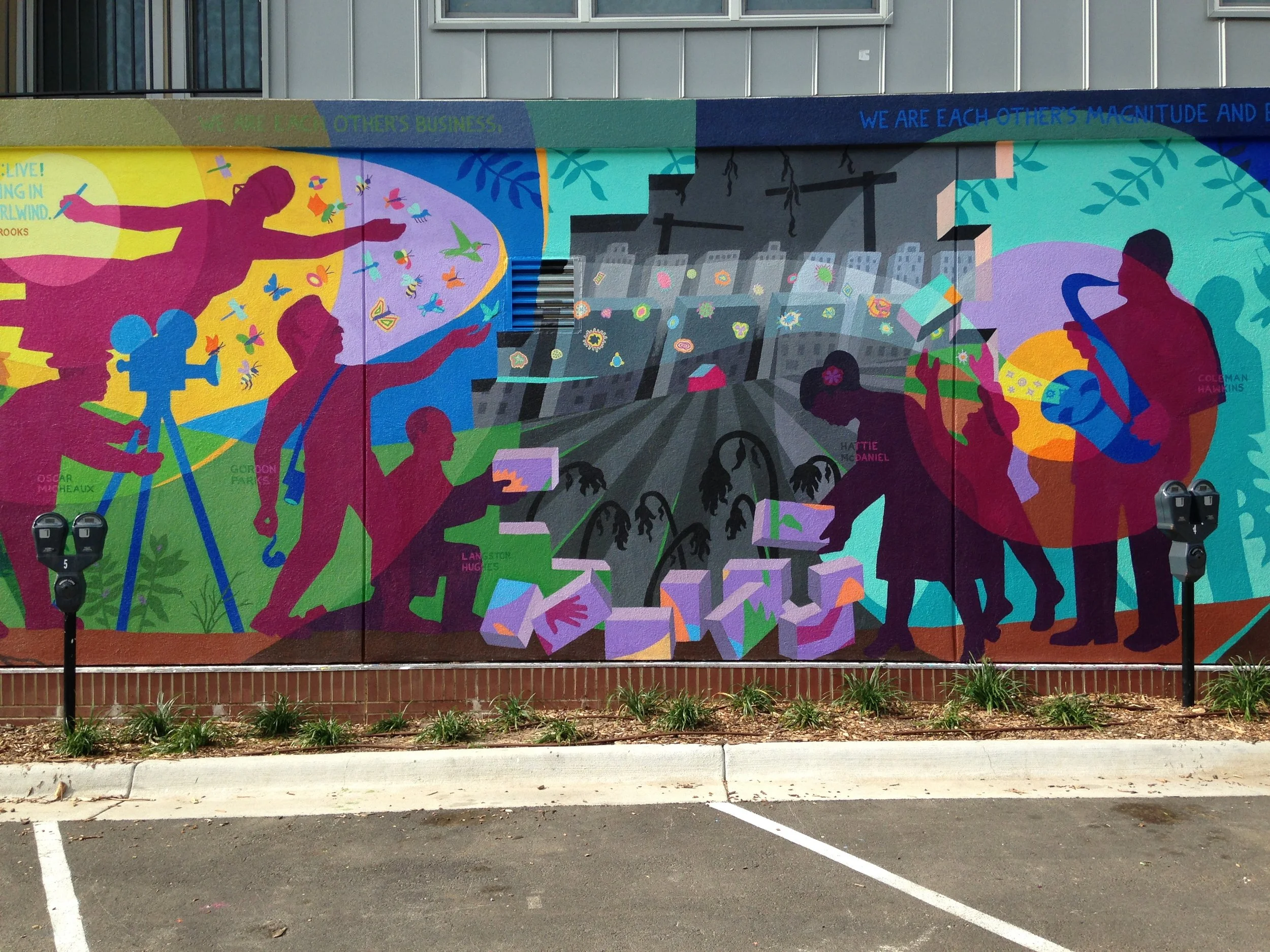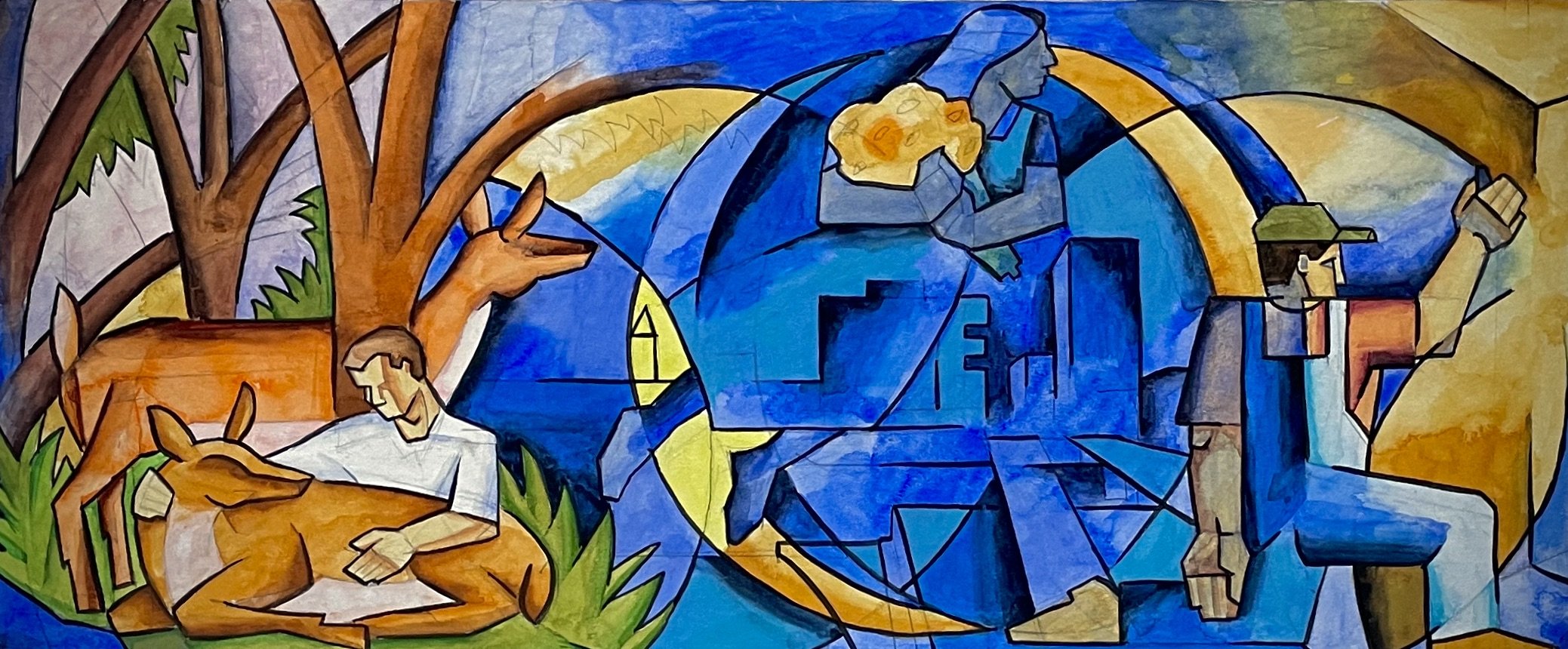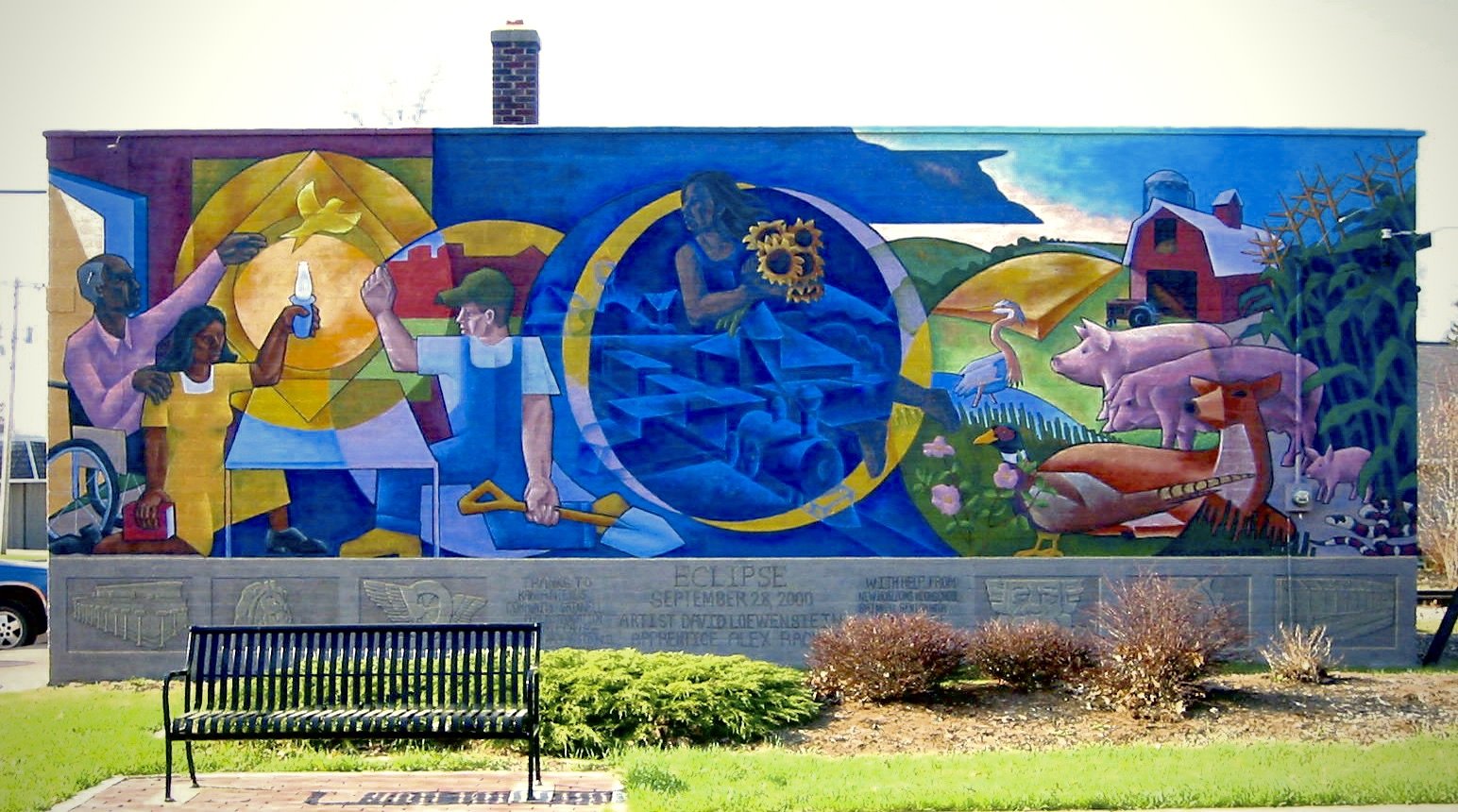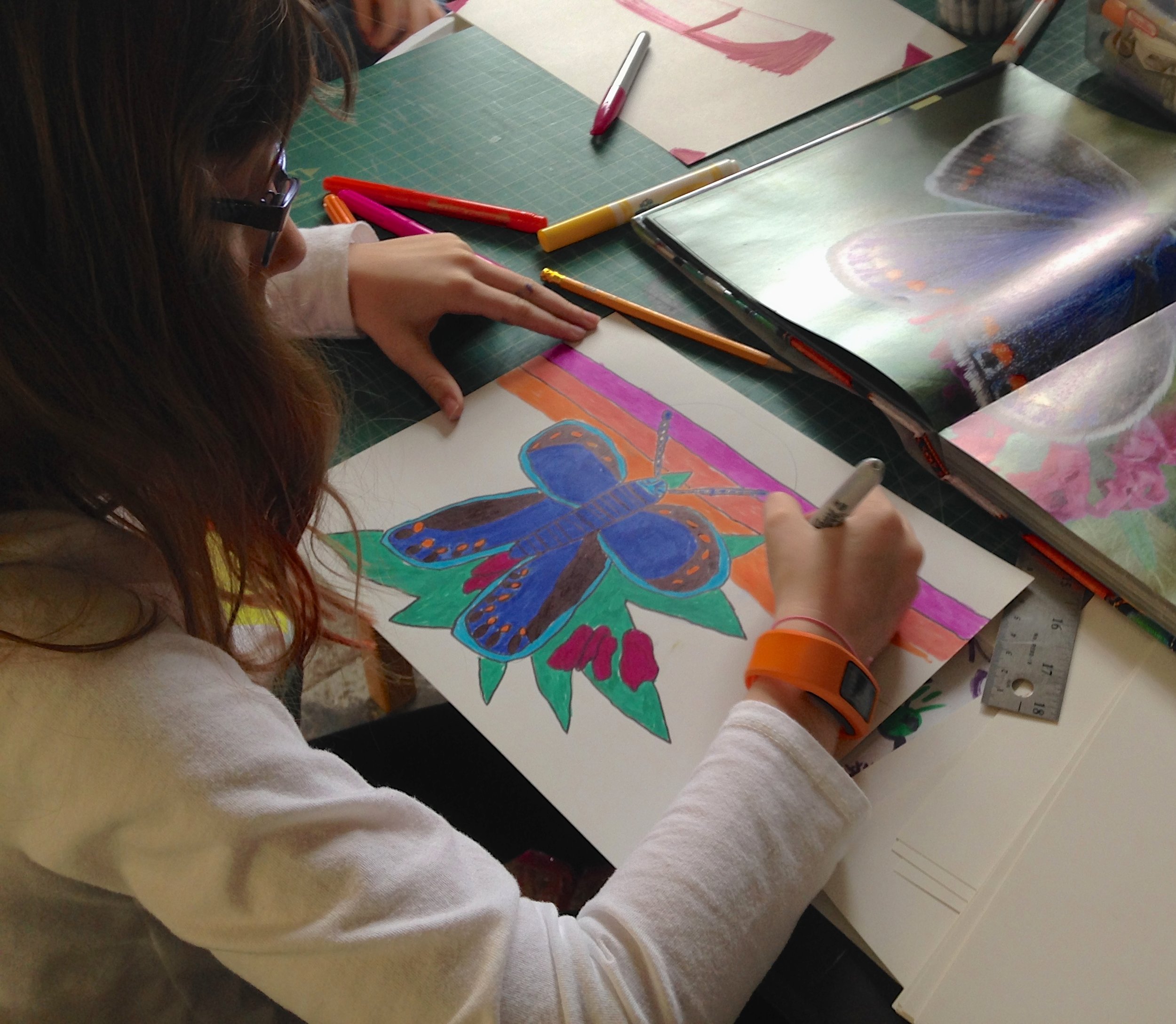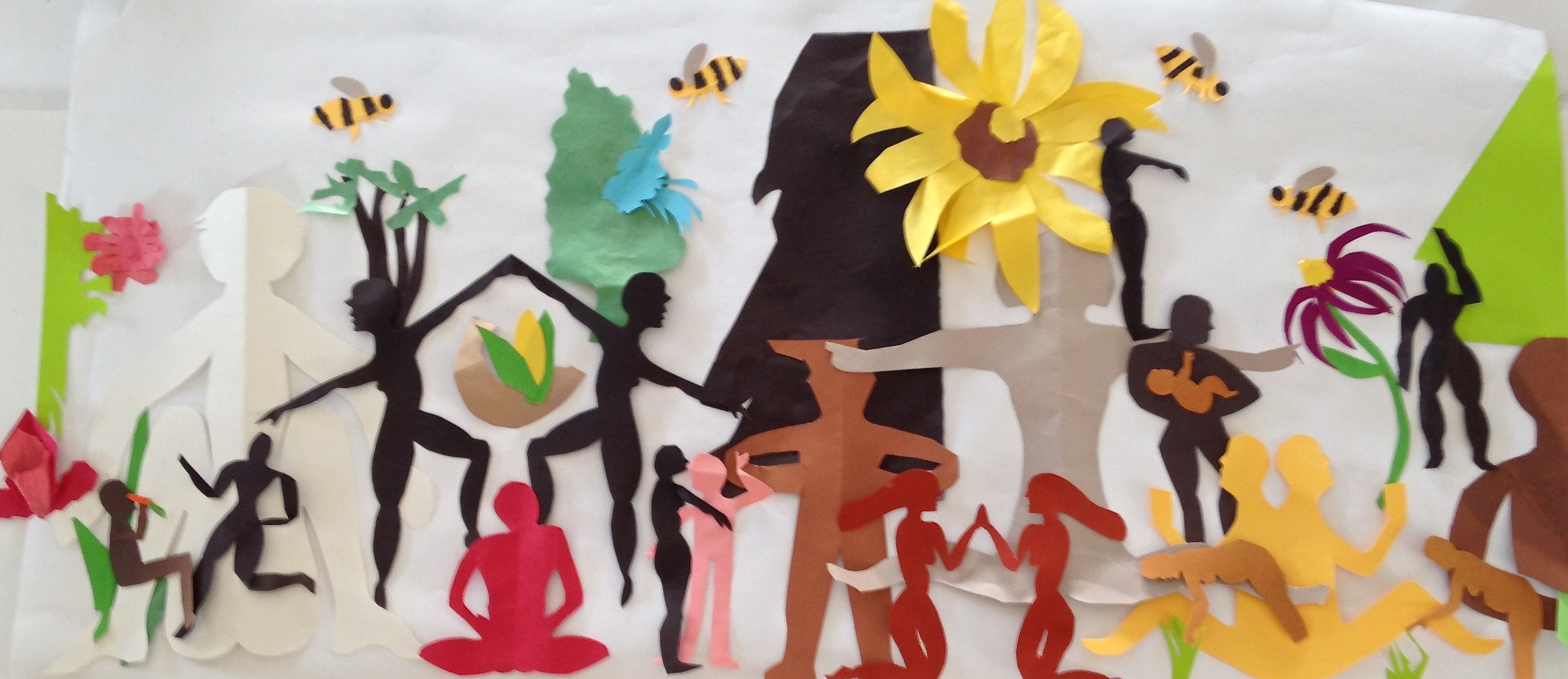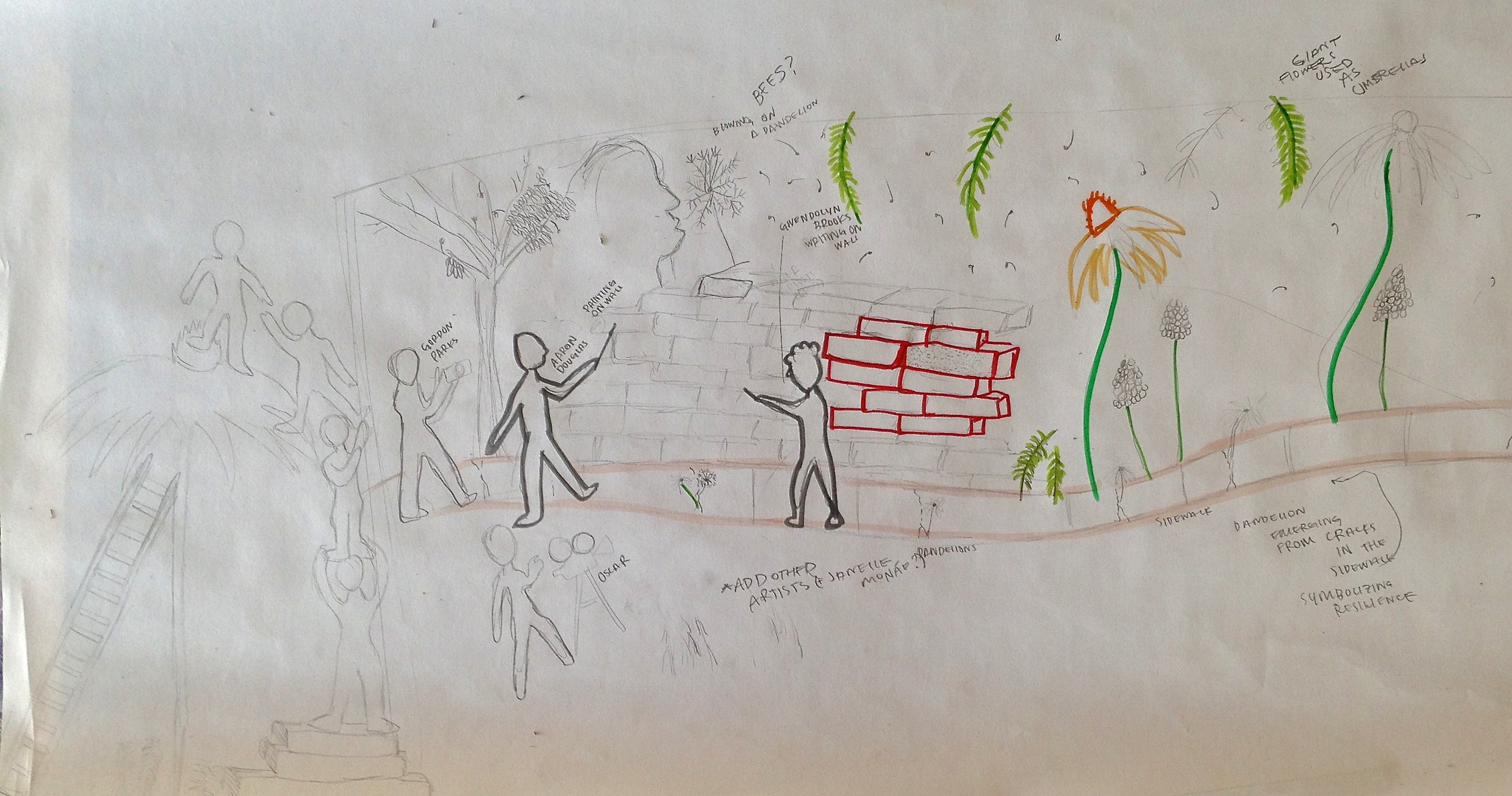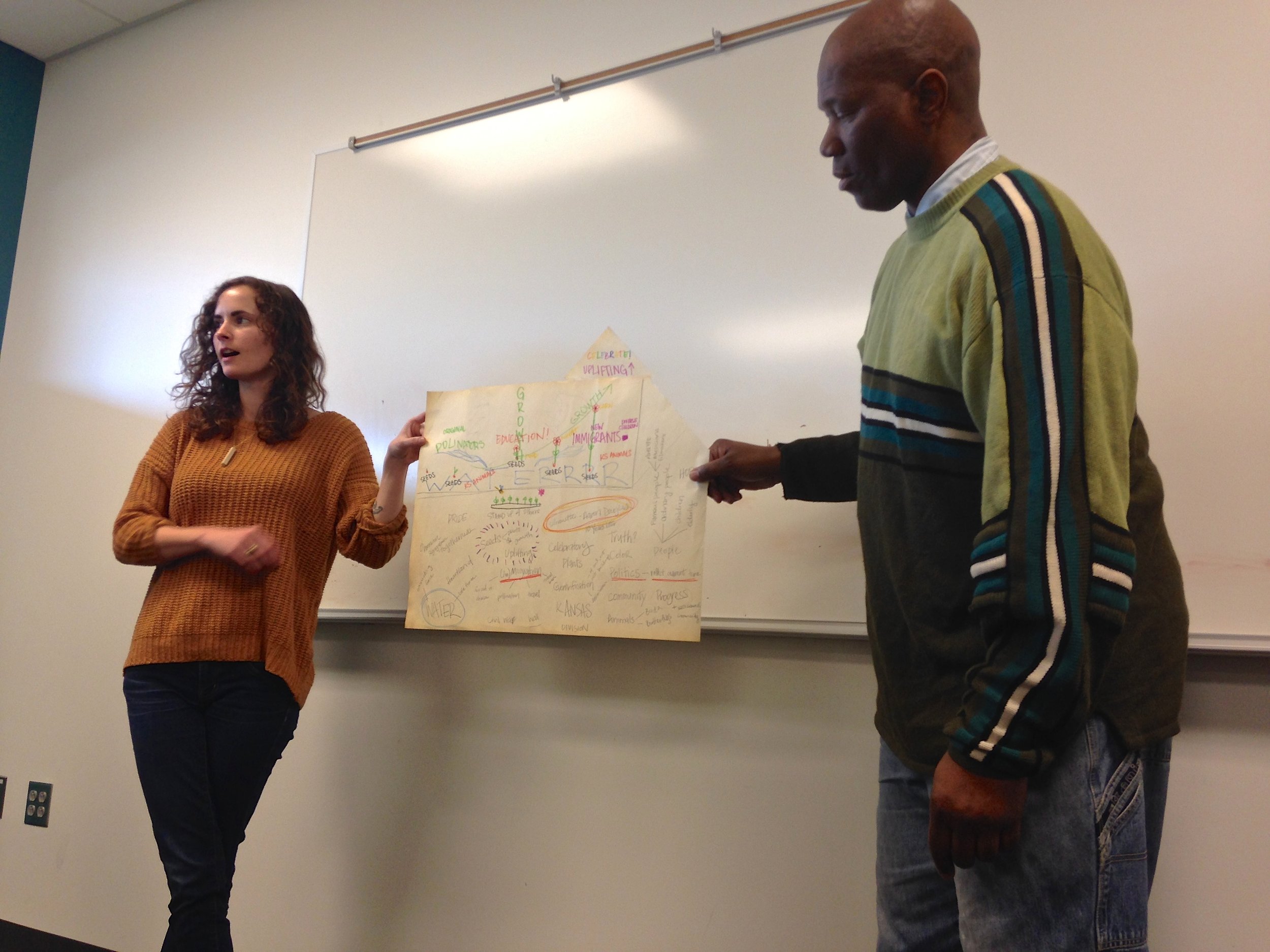It’s been twenty-four years since the “Celebration of Cultures” mural was created in the breezeway between the Antique Mall and Ernst and Sons Hardware, and this summer, we’re going to give it a fresh coat of paint and varnish. You can help by coming by to help paint in July and/or by donating to the “Buy a Block” benefit on-line or this Final Friday at my studio (411 East 9th St.) where each donor of $20 or more will receive a block form the original “Pollinators” mural!
A hub for who?
The Farmers Market. That’s the answer. It’s the perfect spot at the southern entryway to downtown, across the street from South Park and adjacent to two of our most important civic institutions, the Watkins Museum of History and the Douglas County Courthouse. With the addition of Farmers Market at 11th & Mass., in the space where the old A & P grocery store and Allen Press used to be, we would have a remarkable place at the intersection of local food, history and civic participation. A hub for the whole community.
A & P Grocery store at 11th & Massachusetts
I realized that this dream was shared when I visited an open house for Farmers Market held at the Carnegie building last month. Among the displays from area producers was a wall of beautifully rendered architectural views of a new multi-use public space at 11th & Mass. designed with a permanent home for Farmers Market. The solution we hadn’t imagined.
The Allen family would become local heroes for seeing the civic potential of this place and selling the land to the City, and maybe the new Market could carry the Allen name in appreciation of their visionary gift.
Or…
Or, we could get the other HUB, one catering to luxury living only for those who can afford it, a parking nightmare and a blot on our most vibrant and historic civic intersection.
Imagine.
Detail of the mural “Ad Astra” in Hutchinson, Kansas
Rejuvenating the Arts in Kansas - An open letter to Governor Laura Kelly
*UPDATE* July 2, 2019
The Kansas Legislature passed the 2020 budget that includes $500,000 for the Arts, an increase from the past few years where funding was between 0 - $190,000.
Dear Governor Kelly,
2019 marks a hopeful turn for Kansas. Your election as governor and the return of essential tax revenue bodes well for the rebuilding of our state, beginning, as you said in your State of the State address, with education, child welfare and Medicaid. There is also much more work that needs to be done if we want to embody the visionary calling of our state motto, “Ad Astra per Aspera.” A recovery of spirit and imagination are needed as well, one inspired by that poetic aspiration, “To the stars through difficulties,” and supported by you and our legislature.
Our understanding of who we are as Kansans is shaped significantly by the stories we learn and the stories we create. From John Steuart Curry’s fiery depiction of abolitionist John Brown, to the revolutionary poetry of Langston Hughes, to the lost and found journey of Dorothy Gale, to the Afro-Futurist visions of Janelle Monáe to the legacy of the Kansa people, the creative works of Kansans give texture, color and context to our shared identity. This is also true for our own stories made in schools, arts centers and countless other venues, many of which depend on support from our state arts agency. Unfortunately, funding for that agency in Kansas is one of the lowest in all of the U.S.
As you recall, our state arts agency, formerly known as the Kansas Arts Commission, was defunded by a line item veto of Governor Brownback in 2011. This, after a successful bipartisan effort to maintain it in the legislature. Defunding the KAC was tragic and unwarranted. It decimated local arts programming and put Kansas at the bottom of all states in support of the arts. Stifling the arts meant stifling the song, the painting, the poem, the quilt, the play and the dance of Kansas. In essence, it meant stifling the dream of Kansas expressed in our motto.
Since then, we have recovered a little thanks in large part to advocates who worked alongside, KCAIC Director, Peter Jasso to restore funding from the National Endowment for the Arts and Mid-America Arts Alliance. But even with this effort, Kansas still ranked dead last in the U.S. in per capita spending on the arts in 2018. Dead last. For comparison, a couple of our neighbor states are way ahead of us. Nebraska is 23rd in spending, while Missouri is 16th.
We can and need to do better.
What’s at stake is much more than art for arts sake. If we want to truly rebuild not just our critical social programs but also our sense of who we are as Kansans, what we stand for, and what we aspire to, we need to support the next generation of creative thinkers and doers. Let’s fortify them with the resources and tools they’ll need to imagine the culture of equality, education and opportunity so beautifully flowing from the façade of our Capitol at your inauguration. Our goal should be a reinvigorated state arts agency with increased funding, dedicated staff and a broader more inclusive vision of the potential art can have in the lives of all Kansans.
To begin, we could gather together a group of Kansas artists, teachers, arts advocates and administrators for an imagining – a space to envision, explore and begin to plan a rejuvenated state arts agency that is on par with our neighbors in Missouri and Nebraska. The writer and artist Arlene Goldbard (who once consulted with the Kansas Arts Commission) says, “Everything created must first be imagined.”
Let’s imagine together.
Sincerely,
Dave Loewenstein
Tribute to Jack Ozegovic
It was with a heavy heart that I learned of my friend Jack Ozegovic’s (and his wife Ann Carlin Ozegovic’s) passing last month. I was lucky to have known Jack for more than twenty-five years. We met by chance in 1992 at the Lawrence Lithography Workshop, in the space that John Brown’s Underground occupies now. Jack had received a grant to work with Master Printer Mike Sims and I was one of Mike’s slickers (assistants), a work-study job I had while floundering in the MFA program at KU.
Jack in his home studio on Arkansas Street
Angled over a chunk of limestone, looking more than a little like Ernest Hemingway, the print he was working on was one in his Great God Automobile series. It was a tightly composed maze of primary colored symbols alluding to our worship of car culture, and was energetic like board game with a twist of social commentary, his take on the idea of human “progress.” A true modernist, as longtime art writer Leslie Von Holten called him in her remembrance, skilled at re-contextualizing the cultural icons we take for granted, he also made beautiful landscapes, was a hardcore cross-country skier and wrote a sweet book of essays about his earlier life as a professor and winemaker in Michigan.
After that meeting at the lithography shop, Jack and I ran into each other now and then at coffee shops or art openings over the years, until 2009 when I had the thrill of curating a retrospective of his work at the newly opened Percolator. The response was incredible. A packed house for the opening with more visitors and sales than I think the Percolator had ever seen for a show. Jack was blown away. And it was during the run of his show that we started our regular lunch hangouts.
Often we’d meet a La Parilla, where over quesadillas (and occasionally tequila…) we’d talk art and politics. I deeply appreciated his perspective and wisdom. I never told him as much, but he was a true mentor, someone who freely shared his knowledge and experience and didn’t spare his opinions. His faith in art and belief in humor to weaken the powerful helped give me the confidence to double down on the time I spent making radical posters for social movements.
When we talked politics, and in the last six years it was often about the tyranny in Topeka, Jack often referenced his Croatian background and how that had made him a keen watcher and sharp critic of despots, demagogues, and dictators be they human or machine. Jack also walked the talk. He marched, he wrote letters to editor, and once at a mock funeral for the arts at the state Capitol he offered to be the first to get arrested by the police, since he was oldest, he said.
Jack and his wife Ann on the right awaiting the capitol police
He was a passionate supporter of our local arts community, participated in countless benefit shows, collaborated with folks like Dave Van Hee on wild creations, was a regular at final Fridays and always went with Ann to see what was new at the Nelson in KC. He was hungry for art and was thrilled when he discovered an artist he didn’t know, especially a young person.
Here’s a quick email he sent to me awhile back, “Have you seen the elementary kids art show at LAC? Some pretty wild things are there. I was really jolted by it all. Cheers, Jack O.”
My thoughts go out to Jack and Ann’s friends and family.
Jack at the Percolator
View From East Lawrence
Originally made for the exhibition “Art from the Eastside” in 2006, this take on Saul Steinberg’s famous New Yorker illustration was also used as the cover for the deadwood edition of the old lawrence.com. An 11’ x 15'“ inch poster of this is available in my website shop.
Everything Connects to Everything Else
Thirteen years ago students at Lawrence’s Century School imagined making a mural in the empty lot behind their building. Led by a first year teacher, Tim Holtzclaw, they dove in. They studied Diego Rivera and John Steuart Curry. They visited murals in Lawrence and learned about the technical process. Then they researched, discussed ideas and drew, eventually landing on the theme “Everything Connects to Everything Else.” In addition to art, this semester long community project took students out of the classroom and into the world of land ownership, liability insurance and eventually civics at the City Commission chambers where they had to fight for permission to paint.
Parents expressed how impactful the project was in a newspaper guest column where they said, "This, more than anything else, is the gift that Century School has given the Lawrence community: children who see themselves as part of, and as connected to, all that surround them."
Over the years the mural has been the backdrop for a community garden and more recently a small apple apple orchard. It’s been admired by thousands, but won’t be for much longer. Former city commissioner Bob Schumm owns the property just to the north and will break ground on a new apartment building (including a condo for himself on the top floor) that will cover the mural. (UPDATE as of August 1, 2018 - Developer gives up on idea for five-story condo.)
That’s why the mural artists (many in their twenties now) and their teacher Mr. Holtzclaw are having a reunion to celebrate. It’s tomorrow at 5pm at the mural, at 815 Vermont Street. The mural still looks fantastic even without any touch-ups, and the theme couldn’t be more relevant. Go see for yourself while it’s still there.
The Percolator turns 10!
It's the tenth anniversary of Lawrence's grass-roots, home-brewed, free-range art space. The Percolator! Whoa, how time flies. I remember the moment Christina Hoxie suggested we were more than an incubator (like the one in Kansas City), we percolated and dubbed our rag-tag crew the Percolator. There is a great show (opening Friday June 29th) and special events to mark the anniversary detailed here. To spark collective memory here are some of the early show posters. The first two, The Ex-Show and Bikes or Art?, are from the very early days when the Perco was still based in my studio. Enjoy!
Summer Projects: Fireflies, Mosasaurs, Mariposas and a hardware Haven for art
The rising heat is an annual sign for me to get out in the blazing sun and throw myself at the mercy of all biting insects, or in other words get painting on some new murals. This summer, I'll be sticking around the region with projects in Topeka, Ottawa and Haven, Kansas, and one in Iowa City.
Right now, I'm working in Topeka on the second to last panel of the Great Mural Wall, a ten-year project to transform the retaining wall around the city's old reservoir at 20th & Western into a collection of stories that celebrate neighborhoods and explore cultural history. The theme for this panel is water - where it comes from, how we use it, how its threatened, its history in this part of Kansas, and the ongoing struggle to ensure it is clean and available to everyone. Collaborating on this project are local residents who met at the Topeka & Shawnee Library, Quincy Elementary School Students, the Topeka Water Division and noted artist Lisa Grossman. Everyone is invited to come help paint in early June. I'll post details soon.
Later in June, I'll head up to Iowa City to paint one of the few murals I've done that isn't a full-fledged community project. Working with project coordinator, Thomas Agran and folks at Beadology and Over the Moon businesses, I have designed a mural that contemplates the alley culture of downtown and sources of light at night. Think cell phones, fireflies, a full moon, constellations and giant raccoon. If you're in Iowa City June 17-30, come by and I'll be there.
In July, assuming I haven't succumbed to heat stroke and mosquitos, I will begin what aims to become a multi-year cross-disciplinary project to celebrate the life and vision of Ottawa, Kansas artist and lepidopterist William H. Howe. Working in collaboration with the Ottawa Arts Council, Ottawa Main Street and the Franklin County CVB, I'll be recreating one of William's iconic paintings as a mural downtown. The mural will kick-off a project that will include butterfly gardens and a new permanent exhibit about William's life and work.
And before the weather turns, I'll finish up this season in Haven, Kansas, a small town south of Hutchinson. Thanks to the local art teacher Kylee Baldetti, the City of Haven and support from the Kansas Creative Arts Industries Commission, we'll be engaging in a community-based project to imagine Haven as a place and an idea. The mural will be located prominently on the Main Street hardware store and will undoubtedly be a catalyst for conversations and stories about what it means to live and work in Haven.
I am grateful to all of the people who help bring these projects into reality. It takes imagination, belief and a lot of hard work. I could never, and wouldn't want to, make them alone.
Creating Counterparts documentary film
During the course of the 1999-2000 school year, two groups of high school students, one from Holcomb, Missouri population 531 and the other from New York City population 10,000,000, worked together to create a mural about their perceptions of one another and the communities they lived in.
With school in session and more than 1000 miles between them, it was impossible for the two groups to work in the same physical space. The students overcame these obstacles guided by an innovative curriculum I developed with Baruch College Education Professor Sandra Stein that harnessed new computer technology to bridge the physical distance between them and make their collaboration possible.
After eight months of work, the completed mural titled “Counterparts” debuted in New York to a huge reception including, by a miracle of grassroots fundraising, all of the mural team members from both schools.
Creating Counterparts follows this story from the first workshops in both Holcomb and New York where students revealed their guarded perceptions of each other from 1000 miles away, to a serious conversation eleven months later about tolerance and faith, that took place, in South Eastern Missouri.
The film celebrates the capacity of art and technology projects to open doorways and challenge our perceptions. It also shows how this particular project was realized in the hope that others will be inspired to envision their own ways of bridging the divides that separate us.
Watch the entire film here.
Who will speak for the trees?
One of East Lawrence's oldest residents has become the latest victim to gentrification. Yesterday this magnificent tree just north of the Wishing Bench was cut down. (For more about this tree, check out my March 28th post on the "Man!!! Look at This Thing I Saw in a Lawrence, Kansas Alley" Facebook page.)
What’s left of this beauty on November 16, 2020
This is not the first elder tree to lose out to developers. In 1989, activists fought to protect a stand of cottonwoods where the (failed) Riverfront Mall now stands. And in 2003 there was a heated battle between developers of the Hobbs-Taylor building and a coalition of neighbors and activists about the fate of giant elm near the corner of 8th & Rhode Island.
"Save the Tree" at 8th & Rhode Island, 2003
Developers claimed that the tree was dying anyway, was dangerous and would cost too much to save. Sound familiar? Folks hoping to save the tree rallied, made t-shirts, brought in the media and eventually set-up an encampment around the tree to ensure it wouldn't be cut-down by surprise. A mural on the south side of Cottins Hardware by Ardys Ramberg and Missy McCoy memorializes the tree and the fight to save it.
There are other trees, regular everyday trees that don't have advocates like the elders. They disappear daily at the whim of property owners, utility companies and the occasional big wind. One of these anonymous trees was in the line of sight looking out the window of the Lawrence Percolator in 2009 (before the Marriott). For the exhibition, "Trees I Have Known," I created the "Illuminated Nearby Tree," which functioned as a template for people to recount their memories of trees by writing short stories within the illuminated branches. Before the show was over, the tree it was based on was gone too, a inconvenience to builders of the new apartment building and fitness club.
The Wishing Bench at E. 9th & Delaware
Is the Wishing Bench a Canary in the Coalmine?
The end of the Give Take Give
On a walk this fall with my three-month-old son, we took the alley past the Farmers Market parking lot toward the Social Service League. As we crossed 9th Street, I could see my friend Earline leaning into the blue metal dumpster behind the League with a homemade prospecting tool in hand. For years Earline has been collecting reusable and recyclable stuff from the dumpster. In the book documenting the project I created about the dumpster called Give Take Give she said, “I’m ready to cut back, but I don’t want to stop until I know that there’s somebody who will do it faithfully – like a job or something. Then I wouldn’t have to worry about all those hangers going to the landfill.”
Earline James at the Social Service League dumpster
But Earline was struggling, fighting to keep the lid open so she could search and retrieve, and then I realized why. There was a thick metal chain and padlock that was keeping the lid closed. This was new. It never had been locked before. My heart sank. Why would the Social Service League lock the dumpster, effectively putting an end to the gift economy it had been the center of for more than twenty years? In the days that followed, news of the locked dumpster spread, prompting the League to respond in a lengthy facebook post. They said, in part, that due to people making a mess, getting into and sleeping in the dumpster, “the lock was our only choice.” In my memory, these had never been significant issues. Only since a new board of directors and store manager were put in place did these concerns arise.
My son and I were able to walk this route because there’s a lull in construction. The alley had been closed for months, the one where the dumpster I profiled in the Give Take Give project is, and the one adjacent to the Pollinators mural I helped create at Farmers Market. In the last few years, this two-block stretch of New Hampshire St. has been transformed. There are more than one hundred new upscale apartments, a rooftop pool, a Marriott Extended Stay hotel, an expensive wine shop, and a foodie bistro. Looking west from Rhode Island Street, this wall of new five to eight story buildings looms over the houses below them, and stands as a visual and psychological divide between downtown and East Lawrence - on one side, a burgeoning neo-yuppie enclave, on the other side, a historic working-class neighborhood.
East 9th Street looking south between New Hampshire and Rhode Island
Many in East Lawrence opposed these new developments or at least wanted them to be smaller, scaled closer to the aspect of the rest of the neighborhood. And it was this coming wave of construction, and the potential it had to impact the social fabric of the neighborhood, that led me to begin the Give Take Give project. I feared that if the story of the dumpster’s unique gift economy wasn’t captured then, it might be lost forever.
At the end of Give Take Give, I wrote, “Hopefully, this book will not become a nostalgic elegy for something that was. Hopefully, the give take give at the League dumpster continues on where it’s always been.” That was four years ago. The dumpster is still there, but as Andrés and I discovered, now it’s just for trash, locked out of the current of good will that sustained the give take give.
Blowing-up the neighborhood
Changes at the Social Service League are part of an economic and aesthetic revitalization push evidenced by the new building projects spreading out from the intersection of New Hampshire & East 9th Streets and a growing desire among some to see this "corridor" as ripe for Placemaking.
Placemaking is a development tool broadly describing the use of art and artists to increase the economic and social potential of an area often deemed blighted or undervalued. Although it is supported in the field of community development, there is growing body of criticism about Placemaking and how it can contribute to the process of gentrification.
All of this demolition and construction led to talk about whether nearby East 9th Street was about to “Blow-up.” Tourism bureaus and hipsters like to announce that a place is about to "Blow-up" when a formerly uncool (usually working-class) neighborhood sees the influx of foodie food trucks, art galleries and lofts. Lofts!
Ruins of the original Pollinators mural
For a place to really Blow-up, developers often recommend making the desired neighborhood “safer,” so that visitors feel comfortable around the new breweries and coffee shops. This of course is code language aimed at potential investors and real estate speculators signaling that they should get in while they can. And like other redevelopment schemes from the past (urban renewal and manifest destiny to name a couple) a neighborhood that gets blown-up often sees the replacement of established residents and businesses with new ones - in other words gentrification.
Return of the Pollinators
A block north of the Give Take Give dumpster, the original Pollinators mural had already fallen victim to this vision. It was taken down to make room for the new 888 Lofts and rooftop pool, which, no joke, was first occupied by a KU fraternity. Adding irony to this loss was that Pollinators was being demolished at the same time the City was touting its first cultural arts district (which included the Pollinators). This was not lost on neighbors, many of whom saw it as a sign that all the talk of Placemaking was just a way of making the greater goal of upscale development more palatable.
Fortunately, we had some warning about the Pollinators’ fate and were able to organize a response. Although there was no city, state or federal protection for the mural we could point to, love and support for the mural was widespread and folks were not going to accept its destruction as the inevitability of "progress."
After months of negotiation, and with the support of hundreds of Lawrencians, the developer agreed to fund the creation of a new mural in roughly the same place as the original on the new building. That mural, completed in July, pulls no punches. The design team I led was determined that we tell the story of what happened to the original and address the threat posed by the forces that took it down. But I wonder, as I did with the dumpster, if the new mural will become just another elegy, an artifact from a battle lost to gentrification.
Detail from the Return of the Pollinators
In Lawrence, like many cities, when large building or road projects are proposed they must go through a number of reviews including an Environmental Impact Study. This ensures that the proposed activity will not unduly harm protected animals, habitats or public health. We have no review however for how such projects can adversely affect cultural fabric - the ways in which groups of people maintain and practice their culture, including expressions of heritage, language and social gathering. Writer Arlene Goldbard thinks we should. She imagines communities adding a Cultural Impact Study to the review process to make certain that harmful impacts can be addressed and alternatives explored. Proposing such a study, I believe, would start a needed and new conversation about how we imagine Lawrence and what we value as a community.
Three Wishes
On our way home, my son and I walked east along 9th Street past the Turnhalle, past the old Kansas Key Press, past where Rick “Tiger” Dowdell was shot and killed by police, past St. Luke AME, past the community orchard, and all the while on the traditional lands of indigenous peoples including the Kansa, Ioway and Osage, until we got to one of the most improbable and beloved spots in town. It’s known locally as the Wishing Bench - a place not unlike the League dumpster in spirit (pre-lock and chain), where a current of wishes asked for and granted flows through.
The bench, which began as a KU class project, over time has become an improvised community artwork and Lawrence icon with a simple purpose inscribed on a hand painted sign added to its frame. It says, “Sit and make a wish. You won’t be disappointed.” It’s free, unsupervised and since it’s not owned by anyone but sits on the property of an ambitious developer, it’s vulnerable, like a canary in a coalmine. My son was captivated by all of the colors and shapes, the things people had added over the years, which turned the cold metal structure into a kind of shrine to the hopes and dreams of the neighborhood. We sat, and granted ourselves three wishes. He went first (It was something that ended in a ear piercing high-pitched laugh and drool), me next (If I tell, it won't come true) and the last wish we gave back to the wishing bench, cautiously optimistic that it would be undisappointing those who shared their secrets for many years to come.
Dave's new art shop
Check it out! Signed posters, mural postcards, books and more. Everything $35 or less :)
http://www.daveloewenstein.com/shop/
Eclipse the mural
In honor of the upcoming eclipse
Thirty years ago I experienced my first eclipse. It wasn’t total. It was annular, meaning, because of its proximity to the earth, the moon didn’t completely cover the sun. Unsure about what was about to happen, my roommate and I stood outside our apartment in Lawrence, Kansas waiting for something to change. It came as an odd, slow dimming almost imperceptible but for the sounds. The rising sounds of birds and insects and dogs, howls and chirps that would normally happen as evening approached. Like the animals we are, I felt my hackles go up. It was eerie and instinctual.
I also remember an unexpected effect of the eclipse. It was how it brought people together. It was a true spectacle, something outside of the everyday we could all witness but were powerless to control. And it was in that liminal moment that a space in time was opened for passersby and strangers to meet and wonder - together.
Six years later,
I was in Grinnell, Iowa, the small town where I’d gone to college in the 80’s and was back to work on a mural with students from both the town and college. Early in the project at a community meeting folks were having a hard time getting beyond flat characterizations of each other - elitist, townie, hippie, red neck - when I recalled that moment of the eclipse and of how it briefly allowed people who might not normally talk to each other to gaze up at the sky and chat.
study for Eclipse
I thought about one reality obscuring, eclipsing another, what we see and how we adjust to absence. The answer during an eclipse is the wild and beautiful corona, which can only be observed when the moon is directly in front of the sun. When one idea obscures another, sometimes new things are revealed. In awe of the eclipse, we briefly recognize our fragility and connectedness. I shared my thoughts with the mural team and after much discussion and drawing, we chose to represent the Grinnell community coming together during an eclipse.
Article from the Grinnell Herald-Register
The design has four parts. On the left a group of people, in front an iconic Louis Sullivan bank decoration from town, come 'to the table' to work on an issue, make a plan, discuss a problem, and listen to each other. On the far right, a group of local domesticated and wild animals take notice of the humans. And in the center of the mural above the intersection/crossing of north-south and east-west train lines, a symbolic figure brings a gesture of good will, inspiration, solace, across the dark blue disc of the eclipse.
The mural was commissioned by the Grinnell Area Arts Council. My friend Karla Niehus who worked at the Faulconer Gallery and served on the Arts Council was the project coordinator. Grinnell student Alex Racho was the assistant. Students from Grinnell High School, New Horizons Alternative High School and College made up the design team. If you’re driving across Iowa on I-80, stop in Grinnell for a meal at my friend Kamal’s restaurant, Relish, and then check out Eclipse the mural at the corner of 3rd Avenue and Park Street.
Magic of the Maple Seed Fountain
Earlier this summer, I had a great time leading Baldwin City’s first community mural project. Created with the help of more than one hundred residents, it imagines new murals sprouting from giant maple tree seeds filled with images of the community’s history and culture. Known for their distinctive shape and helicopter like flight, the local design team portrayed stories of Baldwin City through maple seeds, parent to the maple leaf and namesake of the community's beloved fall festival.
The ten giant seeds frame images including the Women’s Bridge, champion brick layer Jim Garfield Brown, Baker University, and Signal Oak. At the center of the mural, downtown’s fountain is illuminated by firefly like maple seeds, and encourages visitors to #wear the wings! Thanks to everyone who helped make this project possible, especially Project Coordinator Jeannette Blackmar, Mural Assistant Nicholas Ward, and Mural Apprentices Ella Conover, Alaina Schiffelbein and Megan Young.
See the mural for yourself at 608 High St. in Baldwin City, Kansas.
Preliminary color-study of the mural design
Re-imagined and ready to paint
After receiving Lawrence Cultural Arts Commission and City Commission approvals, securing liability insurance and getting the ok to use five parking spaces in front of the wall, we finally have begun painting. Over Memorial Day weekend, no less than 130 people helped revive the Pollinators by adding their own brushstrokes.
The design for the mural is based on an intensive community-based process that I led this spring with the help of Nedra Bonds, Janada Birdling, Eugene Sarmiento, Susan Earle and a volunteer design team. We explored the original project, it’s untimely demise and how a new version of the mural could reflect a changed environment ten years later. Our new design engages with those forces that inhibit or threaten pollination, considering questions about what plants and creatures are thought of as pests or weeds and why. And it celebrates the capacity of art and artists to envision a more just and sustainable world.
The new design shows the original artists addressing threats to pollinators by working together to rebuild their mural and create a more sustainable habitat for all. In this new design, Gordon Parks, Hattie McDaniel and Langston Hughes reassemble pieces of the original mural, while Oscar Micheaux documents. Coleman Hawkins saxophone plays more than music now as it releases brilliantly colored pollen grains toward awaiting flowers.
Pollen grain drawings made by visitors to farmers market
And Gwendolyn Brooks has taken off from the ground with a wave of pollinating creatures (many created by young people at New York School) rushing toward a desaturated landscape hoping to bring color and vitality back. As she flies, she writes a new quote into the sky, “And this is the urgency: Live! And have your blooming in the noise of the whirlwind.”
Pollinators made by youth in the Sunrise Project Food Rocket program
Our team recognized that the original group of artists (Pollinators) all came from a particular time period associated with the Harlem Renaissance, and wanted to add more contemporary figures to help broaden the mural’s meaning. Added in the design is a new generation represented by a boy on the right helping to reconstruct the original mural, a girl on the left receiving A. Douglas’s palette like a baton in a relay, and the musician and actress Janelle Monáe inspiring the group with song.
A public celebration of the (almost) completed mural will be on Friday, June 9th at 5:30.
MayDay 2017
North American marsupials are organizing. Join them in the streets on May 1st ! Get your own free download of this poster at Justseeds.
Designing a New Habitat for the Pollinators
It’s getting lighter. Daylight savings time is back. Mural season. Flowers awaiting pollination are beginning to bloom, daffodils and dandelions first. Bees are appearing and monarchs have begun their migration north from Mexico. There’s front-page news in the Journal-World that a fraternity of eighty-seven guys has moved into the 888 New Hampshire building (where our mural will be), while their palatial estate was being renovated. Closing in on the north side of the farmers market parking lot, construction continues on a yet another upscale apartment building shrinking evermore the neighborhood’s habitat for affordable housing.
In the studio a couple blocks away, we began imagining how the Pollinator artists would have responded to the destruction of the original mural, and how they would feel about changes to the neighborhood. Would they act to protect and defend natures’ pollinators against threats to their habitat? How would they respond to the new building on which they would be painted and what it signaled for the East side of Lawrence? Would other artists be compelled to join them in their struggle?
Our initial drawings illustrate a tension between competing ideas about how neighborhoods develop and change, and who or what affects that change. As we worked, we talked about the tools and strategies artists posses to address these issues - how music, poetry, film and painting can shift perceptions and inspire action.
As space for affordable housing shrinks near downtown, so does the habitat for nature's pollinators. Market driven monoculture has replaced many wild and organic backyards and greenspaces in Lawrence with chemically enhanced weed-free sod. Dandelions are the enemy, technology the solution as with these newly developed 'drone pollinators.'
This kind of erasure isn't new. Mural Assistant Nedra Bonds has seen it before. In the 1980's, the historic site of Quindaro, near Nedra's home in Kansas City, Kansas, was nearly turned into a trash dump. No one in power seemed to care that Quindaro had been established by Wyandots and Abolitionists to fight pro-slavery forces until Bonds and others started to make a fuss and tell the story through quilts. It is now on the National Register of Historic Places.
Nedra sharing her Quindaro quilt at our Design Team workshop
So what's the antidote to market driven monoculture? Wes Jackson at the Land Institute calls it perennial-polyculture, a practice of mimicking the prairies of central Kansas to produce crops that don't require the soil numbing toxins used in industrialized agriculture. We asked ourselves what a perrenial-polyculture of built structures and human community would look like in Lawrence. Our answer meant aligning the mural design with wind-blown seeds, weeds and migrating pollinators both human and winged who eschew monotone and monochrome for a full spectrum of experience.
Re-imagining the Pollinators
For many Lawrence folks, especially those that frequent Saturday farmers market, the Pollinators mural and its untimely demise are still fresh in their memories. News that the mural would have a second life was celebrated but also prompted many questions. Where would the new mural be located? Would it be the same size? Who would design and paint it? And most crucially, would the design be the same, including the seven African-American artists and the Gwendolyn Brooks quote, “We are each other’s harvest; we are each other’s business; we are each other’s magnitude and bond”?
Answering the first three questions was easy. The new mural would be at the same relative location (the north facing wall adjacent to farmers market), although only about half as large. The muralists, as I mentioned in our previous blog post, would be comprised of both new and old design team members plus a new assistant and two new apprentices. Much more difficult to answer is the last question - how would the design be different from the original, what would remain, what would be changed, and what would be added?
Since early February, our design team has been grappling with these questions. Early on we chose to not merely reproduce the original Pollinators, but to re-imagine it. We committed to honoring the original while adding elements that speak to a new time and new circumstances.
There are a few precedents for re-imagining a mural. The iconic “Wall of Respect” in Chicago, which evolved over the years with some images being replaced with others as needed, is probably the best known.
The "Wall of Respect" in Chicago, Illinois.
The idea that a mural does not necessarily have to be static or ever really finished, that it can be a living expression that grows and changes with the times has been a compelling notion for our design team. Because visual art is bought and sold as a commodity, there is less opportunity to change something after it's left the studio, while re-imagining artworks in other media like dance and theater is much more familiar. It’s not uncommon to see reinterpretations or updated versions of well-known stories from the likes of Shakespeare or August Wilson set in new contexts with casts that reflect different points of view. We have that opportunity because the Pollinators is being recreated and we can make changes if we wish. It would be a much different story for folks at the Spencer Museum and City, I imagine, if the original mural was still there and we proposed to change and adapt it.
To ground our re-imagining, we began at the Lawrence Public Library with research about the original Pollinators, it’s subject matter and design, and how the community came together to ensure it would rise again.
The team felt strongly that this story of why the mural was destroyed and the community effort to restore it needed to be depicted in some form. The fate of the Pollinators is connected to the larger story about how downtown Lawrence is changing and who will benefit from those changes. Re-examining the central metaphor from the original mural, we began thinking about the factors, agents, etc. that inhibit or block pollination in nature. This led us to question what factors might inhibit the ability of the artists depicted (and their descendants) to ‘pollinate’, and how analogous forces could prevent cultural cross-pollination in the larger community. Big questions.
So, instead of separating our discussion about the biology of pollination from the African-American artist pollinators in the mural and the cultural impact of new development, we let these ideas overlap, complicate and influence each other. We talked about monoculture in agriculture and how to spot signs of monoculture within the cultural community of Lawrence. We talked about the shape and structure of pollen grains, the persistence, beauty and utility of 'weeds', contemporary African-American artists with roots in Kansas, and we talked about how upscale development is encroaching on the East side with uncertain consequences. Our research and conversations produced a wealth of ideas.
In this way, the re-imagined Pollinators project has become a forum for creatively addressing important issues including affordable housing, food justice, and people’s history. This is intentional. Inspired by the examples of artists Liz Lerman, Augusto Boal and Judy Baca, our approach is founded on the idea that a collaborative creative process can illuminate and articulate community conflicts and aspirations in ways that can lead to equitable and just solutions.
Next, we begin to visualize the mural design…
Fate of the NEA and NEH
For the first time since they were created in 1965, a president has proposed eliminating the National Endowment for the Arts and National Endowment for the Humanities. #SaveTheNEA, #SaveTheNEH
International Women's Strike
In solidarity with the International Women's Strike, here are portraits of two incredible women. CJ Brune, who passed in 2015, was one of the original February Sisters and a lifelong activist who I was lucky to know as a friend and mentor. My mom Pamela, still alive and kicking, is pictured on her soap box fighting, as she has her whole life, for women's rights and social justice.
Mom and "CJ" together in 2016







